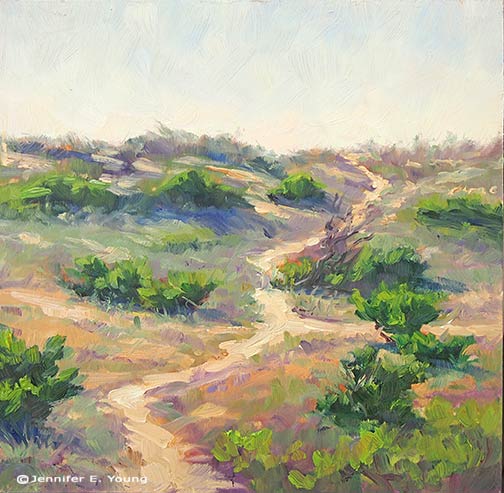My Facebook page, plus two plein airs from the OBX
/It's been such a while since I've provided some blog love, but there's been so much going on this summer that it's been hard to keep up. However I do have two little plein air pieces I'd like to share, having just returned from a fabulous week on Hatteras Island in North Carolina's Outer Banks:
These are both 8x8 studies done on birch panels, painted from the lower and upper decks of the beach house we rented in Salvo. I only painted on a couple of mornings (it was the hubby's vacation too, after all) but I so love painting there that I look forward to doing more and more of these in time. Here you can see me through the picture window, painting on the deck, while the kiddos finished up their breakfast. You might just be able to make out a cup of coffee on the railing. I had my breakfast delivered easel-side, too! Not a bad way to spend the morning. :-)
I didn't get to paint out on the shore due to either the timing or the wind, but hope to do so when we return to the Outer Banks in about a month. Though the legs are starting to go, I'm still lugging my big old Soltek easel around. However I'm finding it more and more cumbersome for travel. I may have to dust off my little Prochade kit for my next trip, though I will need to get used to the much smaller palette size again, and the fact that it does not stand up well at all to any kind of wind.
This is the first time I have painted on shellacked birch panel, but I really like it. I prepared my own panels with Zinsser Bullseye Shellac, two coats per side, and sanding in between. I have heard about this kind of panel before, but it was most recently recommended by Matt Smith in his workshop that I attended in the Spring, so I was eager to try it after that. I was a little afraid that the shellac would make for too slick a surface, but it was the just right amount of smoothness and tooth. It did take a little preparation, but once the panels were sealed, the wood provided a lovely blonde tone on which to paint...no extra toning needed.
One final note, I have finally created a Fan page on Facebook, on which I plan to update with announcements and goings on. You'll find a link to it in this post and also in the right sidebar. I guess I'm not exactly on the bleeding edge, but at least now I can finally say, "Like us on Facebook"!






















